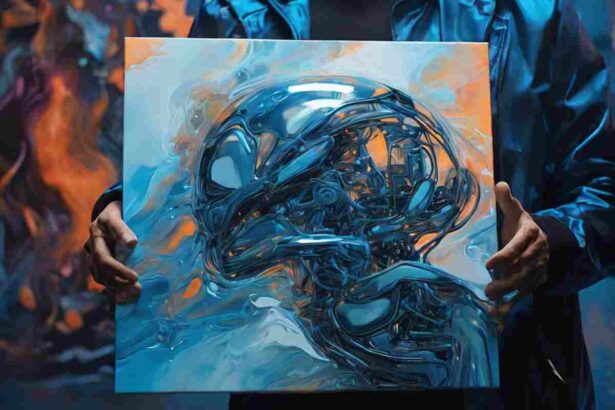Large NFT collections are experiencing significant declines in price. Bored Ape Yacht Club recently plummeted over 80% from their peak values in Ethereum terms. Despite this, the NFT market remains dominated by these large collections – usually “PFPs” (profile pictures) which you can use as your social media profile picture. They account for roughly two-thirds of the market size.
The vast majority of these collections share a common characteristic. Their underlying images are, at least partially, computer generated. For example, each Bored Ape is randomly generated from a selection of 170 unique traits such as hats, shirts or background. The significant role of a computer in the creation of art deserves careful attention.
Existing intellectual property guidelines suggest that images linked to popular NFT collections might not be protected by copyright. In such a scenario, everybody could freely use these images leaving both companies standing behind these collections and NFT holders unable to take any action.
History of Copyright Law
Prior to the invention of the printing press in the fifteenth century, copying was a difficult task. It involved extensive labor and therefore concerns regarding unauthorized duplications were not worth much attention.
Automated printing allowed for easy creation of identical copies. Laws needed to react as suddenly individuals with a printing press were able to easily produce copies. These laws aimed to grant copyright – “the right to copy” – exclusively to authors for a designated period following the work publication. The main purpose was to guarantee that authors are sufficiently rewarded for their creative efforts as artists also need to provide for themselves.
Only Humans Are Privileged
Animals lack this need as they don’t require money for their survival. In 2011 a macaque in Indonesia stole a camera and made several selfies of itself. The camera owner managed to recover the photos and publish them in a book.
The organization People for the Ethical Treatment of Animals (PETA) filed a lawsuit, claiming that by publishing the photos, the photographer infringed monkey’s rights.
The US court ruled that animals cannot hold copyright as this right only serves human beings. However, as the photographer did not capture the photos by himself, he does not possess it either. The photos are considered to be in the public domain available to be used by anyone.
Is Artificial Intelligence Privileged?
The same principle should apply to computer generated works, as computers also don’t require money to survive.
However, despite fast development in the field, it is still practically impossible to have a work generated by a computer without any human involvement. Human input usually consists of writing instructions, selecting input data or establishing rules governing the software creating the work. Are humans performing such activities owners of generated works?
The U.S. Copyright Office
According to U.S. authority overseeing copyright registration and providing guidance on copyright, determining whether a work qualifies for copyright protection should start with a question of whether the computer merely assisted or actively executed the artistic creative expression. The Copyright Office clarifies that if a software receives solely a textual instruction from a human, the final work is not protected, just as providing instructions to an artist does not make you the copyright owner of such work.
The US Copyright Office says you can’t copyright Midjourney AI-generated images https://t.co/NcGT7O2WWZ pic.twitter.com/wEzHj1utwz
— The Verge (@verge) February 23, 2023On the other hand, if a human creatively modifies or arranges the generated work to such a degree that the modifications meet the standard for copyright protection, the work can be eligible for protection.
The European Commission
The EU shares a similar perspective as demonstrated by the European Commission’s report. The report divides the creation process of AI-generated works into three stages:
- The conception phase: the software and input data are selected, design choices are made.
- The execution phase: the plan and gathered data is translated into a draft version, such as generated text or a picture.
- Redaction phase: processing of the draft through formatting and editing.
The European Commission suggests that the presence of creative choices made by a human in both the conception phase and the redaction phase is sufficient for copyright protection of such work.
Are Bored Apes Privileged?
The above mentioned guidelines suggest that Bored Apes are protected by copyright only if Yuga Labs, the company standing behind Bored Apes Yacht Club collection, performed creative changes to the computer generated pictures before selling them.
In a well-known case Yuga Labs v Ryder Ripps, Yuga Labs filed a lawsuit against an artist Ryder Ripps who created an NFT collection titled RR/BAYC using the original Bored Apes images. Even though Yuga Labs argued infringement on many grounds, they – in its 44 page lawsuit – did not mention copyright infringement once.
It suggests Yuga Labs did not want to open this issue up as a court’s negative binding decision could have serious impacts to the collection value.
The Future of Large NFT Collections
The absence of copyright protection for these collections could greatly impact their value. NFT holders would maintain their community status, special access privileges and potential airdrops. However, they would not enjoy exclusive rights to the underlying images.
NFT holders could still create a brand around the images or print it on merchandise but these opportunities would be accessible to anybody, similar to the scenario with macaque selfies. The lack of copyright protection would grant freedom to anyone to use the images as their profile picture, leaving the holder and Yuga Labs powerless to intervene.
Large collections are not only surrounded by copyright uncertainty. They also face regulatory challenges. The European MiCA regulation, set to take effect in 2025 in the EU, is likely to force issuers of large NFT collections to submit a whitepaper and explain why the tokens do not qualify as securities to the relevant EU authority. Simultaneously, issuers will need to follow rules concerning marketing communications and act in the best interest of token holders.
Similarly, the U.S. Securities and Exchange Commission is suing Yuga Labs and other companies standing behind large collections for breaching securities laws. The determination whether such NFTs are classified as securities in the U.S. is still pending.
All these factors could potentially affect – or have already started to affect – the value of large collections. On the other hand, this might give this technology an opportunity to start being practically utilized in real world assets and traditional art, finally realizing their true significance.
Learn more about non-fungible token use cases in previous articles: A Guide to Phygitals and Their Significance, Exciting Use Cases Beyond Art Collectibles and Non-Fungible Tokens & Virtual Real Estate: All You Need to Know.
Disclaimer
Please be aware that legal matters mentioned in this article are simplified to enhance comprehension and are not intended to serve as legal advice. Moreover, please have in mind that each country has its own laws that might govern everything mentioned above differently. Should you require legal assistance, please consult with a qualified attorney or email us at: [email protected].



















